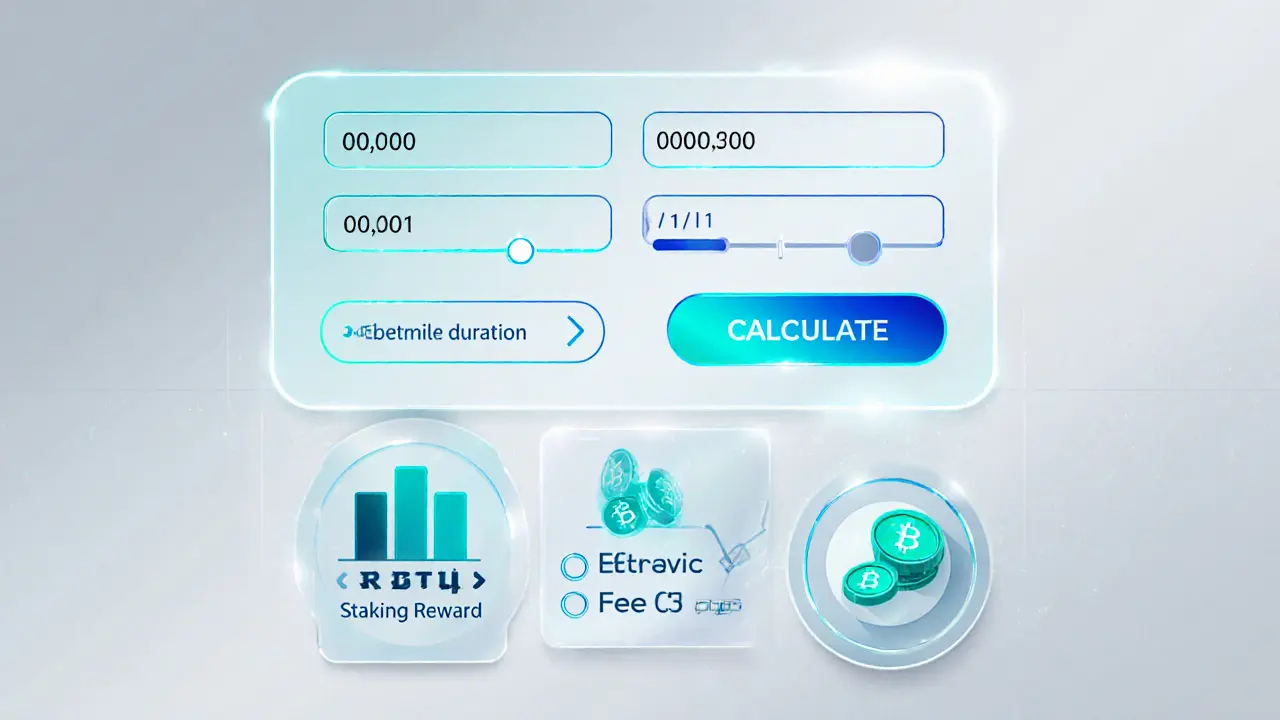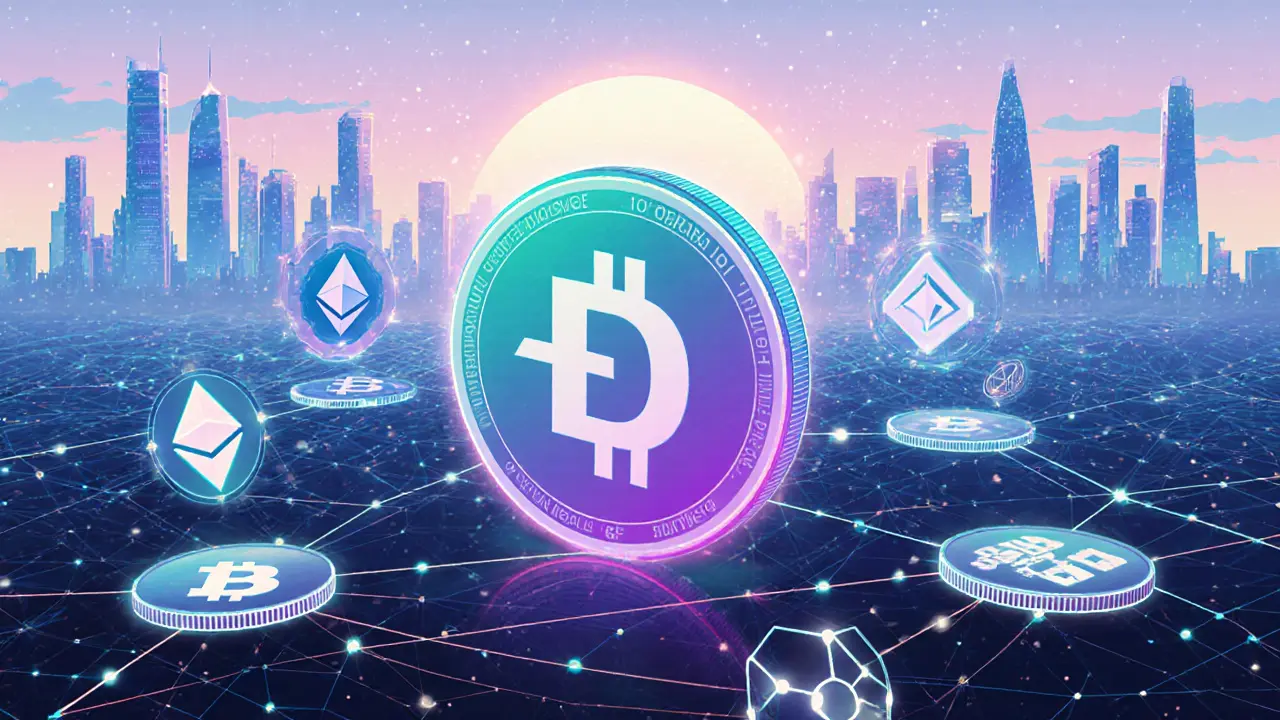Dec 9, 2024, Posted by: Ronan Caverly

ORDER Token Calculator
Quick Facts
- Ticker: ORDER
- Current price (Oct2025): $0.35 USD
- Launched: 2022
- Built on: OPStack L2, settles on Ethereum
- Key uses: trading, staking, governance, payments
What Is Orderly (ORDER) Crypto Coin?
In plain terms, Orderly Network is a decentralized trading infrastructure that unifies liquidity across multiple blockchains through a shared order‑book system. The native token, ORDER (ORDER token), powers the platform: it’s used for transaction fees, staking rewards, governance votes, and even for supply‑chain‑style order management.
Even though some sources describe Orderly as a supply‑chain management tool, the core of the project is a cross‑chain decentralized exchange (DEX). It blends the speed and order‑matching precision of a centralized exchange (CEX) with the trust‑less nature of a DEX, aiming to solve the chronic liquidity fragmentation that plagues DeFi.
How the Architecture Works
The platform is built on a three‑layer stack:
- Asset Layer - Users deposit assets (mostly USDC) into a vault. This layer isolates funds from the execution engine, reducing risk.
- Engine Layer - A high‑speed matching engine aggregates buy and sell orders in real time. The engine runs on Orderly’s L2 chain, which uses the OP Stack (a modular set of L2 building blocks created by Optimism) for scalability.
- Settlement Layer - Matched orders are batched and settled on the Orderly L2, then periodically rolled up to the Ethereum (the world’s most secure smart‑contract platform) mainnet, inheriting its security guarantees.
Cross‑chain communication is handled by LayerZero (an omnichain interoperability protocol that relays messages between blockchains). This lets traders move assets and orders across chains without needing separate bridges for each network.
Token Utilities - What Can You Do With ORDER?
The ORDER token has four core functions:
- Trading Fees - Pay fees on spot and perpetual markets using ORDER for a discount.
- Staking - Stake ORDER to earn a share of platform revenue and help secure the network. Stakers receive rewards in ORDER and sometimes a portion of transaction fees.
- Governance - Token holders vote on protocol upgrades, fee structures, and new market listings through on‑chain proposals.
- Payments - Pay for premium services, such as advanced analytics or API access, directly with ORDER.
Because the platform requires USDC as the base trading currency, users often convert other assets to USDC first, then trade. This design simplifies price discovery and reduces the number of required liquidity pools.

Security Measures and MEV Protection
Miner Extractable Value (MEV) is a big pain point for DEX users. Orderly tackles it with three layers of protection:
- Fast Matching - The sequencer matches orders within milliseconds, shrinking the window for front‑running.
- Batching - Transactions are grouped before being sent to the L2, making it harder for bots to isolate a single profitable slice.
- On‑Chain Settlement - All matches are finally recorded on Ethereum, leveraging its atomic finality.
These safeguards, combined with the L2’s built‑in censorship‑resistance, give traders confidence that their orders are executed fairly.
Market Position - Why Does Orderly Matter?
Liquidity fragmentation is the Achilles’ heel of most DeFi DEXs. Every chain runs its own order books, and arbitrageurs hop between them, leaving traders with thin depth on any single chain. Orderly’s unified order‑book aggregates orders from all supported chains, presenting a single, deep market for each asset pair. This mirrors how a CEX pools liquidity, but without a custodial middleman.
According to market data (Sept2025), ORDER sits in the top‑700 cryptocurrencies by market cap, trades on 49 exchanges, and enjoys a fairly even distribution of volume across spot and perpetual markets. Analysts see strong upside because the platform’s cross‑chain model aligns with the broader DeFi trend toward interoperability.
How to Buy and Trade ORDER
Getting your hands on ORDER is straightforward:
- Choose a reputable exchange that lists ORDER (e.g., CoinSwitch, Binance, or KuCoin).
- Complete KYC if required, then deposit fiat or a major crypto such as USDC.
- Search for the ORDER/USDC pair and place a market or limit order.
- If you plan to stake, transfer the tokens to the official Orderly staking contract via the platform’s UI or a supported wallet (Metamask, WalletConnect).
Because the token settles on Ethereum, you’ll need a small amount of ETH to cover gas when moving ORDER off‑exchange to a personal wallet.
Future Outlook and Potential Challenges
The roadmap points to tighter integration with LayerZero, additional perpetual markets, and expanded governance tooling. If Orderly can keep its messaging clear-positioning itself primarily as a cross‑chain DEX rather than a supply‑chain platform-it should attract both traders and institutional liquidity providers.
Possible headwinds include competition from other omnichain DEXs (e.g., THORChain, Across) and the need to maintain low latency as more chains join the ecosystem. Nonetheless, the combination of a unified order‑book, strong MEV defenses, and real‑world token utilities gives ORDER a solid foundation for growth.
Key Takeaways
- Orderly Network offers a unified order‑book across blockchains, reducing liquidity fragmentation.
- The ORDER token is central to fees, staking, governance, and payments.
- Security is reinforced by fast matching, batching, and on‑chain settlement, mitigating MEV risks.
- Trading is accessible on dozens of exchanges; staking can be done directly through the platform.
- Future growth hinges on clear positioning and continued cross‑chain expansion.

Frequently Asked Questions
What blockchains does Orderly support?
Orderly currently bridges Ethereum, Binance Smart Chain, Polygon, and Avalanche via LayerZero. New chains can be added through community proposals.
How does staking work?
You lock ORDER in the staking contract for a chosen period (typically 30‑90days). In return you earn a share of platform fees plus optional bonus rewards. Rewards are paid out in ORDER.
Can I trade perpetual contracts on Orderly?
Yes. Orderly offers perpetual swaps for major assets like BTC, ETH, and SOL. All perpetual trades use USDC as the quote currency and are settled on the Orderly L2 before final roll‑up to Ethereum.
Is ORDER a governance token?
Yes. Holders can vote on proposals ranging from fee adjustments to new market listings. Voting power is proportional to the amount of ORDER staked.
Where can I store my ORDER tokens safely?
Since ORDER is an ERC‑20 token, any Ethereum‑compatible wallet works: MetaMask, Coinbase Wallet, Ledger hardware, or the native Orderly app.
Write a comment
Comments
Rasean Bryant
The unified order‑book really streamlines cross‑chain trading. By pooling liquidity from multiple chains, traders experience tighter spreads and reduced slippage. It also lowers the barrier for newcomers who no longer need to hop between separate DEXs. Overall, it’s a promising step toward a more cohesive DeFi ecosystem.
December 9, 2024 AT 09:04
Angie Food
Orderly sounds like just another overhyped token pump, probably a copy‑paste of existing ideas with a shiny new name. Who really cares about “unified order‑books”? It's just marketing fluff.
December 12, 2024 AT 06:31
Jonathan Tsilimos
Orderly's architecture can be delineated as a tri‑tier construct comprising an asset custody layer, a high‑throughput matching engine, and a roll‑up settlement mechanism. The utilization of OP‑Stack L2 furnishes scalability whilst preserving Ethereum's security guarantees. Cross‑chain interoperability is facilitated via LayerZero, thereby obviating the exigency for bespoke bridges. Such modularity is conducive to extensibility and systemic resilience.
December 15, 2024 AT 03:57
jeffrey najar
Let me break down why the ORDER token is more than just a speculative asset.
First, the staking model aligns incentives: when you lock ORDER, you earn a portion of the platform's revenue, which creates a passive income stream.
Second, the discounted fee structure directly benefits high‑volume traders; using ORDER to pay fees can shave off up to 20% of transaction costs, which adds up quickly.
Third, governance participation means token holders have a real say in protocol upgrades, fee adjustments, and new market listings, fostering a community‑driven roadmap.
On the security front, the fast matching engine reduces the window for front‑running, while batching transactions and final on‑chain settlement mitigate MEV risks.
The L2 roll‑up design ensures high throughput without compromising Ethereum's decentralization guarantees.
From a liquidity perspective, the unified order‑book aggregates depth across multiple chains, delivering tighter spreads than most single‑chain DEXs.
This aggregation also lowers price impact for large orders, which is especially valuable for institutional participants.
Moreover, the native token utility creates a virtuous cycle: increased usage drives demand for ORDER, which in turn funds further ecosystem development.
Staking also serves a network‑security function, as locked tokens help secure the protocol against certain attack vectors.
The tokenomics include a modest inflation rate that funds rewards, avoiding excessive dilution while incentivizing long‑term holding.
On the user experience side, the platform’s UI is designed to be intuitive, lowering the learning curve for newcomers.
Integrations with popular wallets like MetaMask and WalletConnect ensure seamless fund transfers and reduce friction.
Finally, the roadmap outlines expansions to additional chains via LayerZero, which will broaden the liquidity pool even further.
All these factors combine to make ORDER a utility‑rich token with multiple avenues for value capture, not just a speculative meme.
December 18, 2024 AT 01:24
Rochelle Gamauf
While the exposition of Orderly's features is comprehensive, one must question the sustainability of its fee discount model. Offering a 20% reduction presupposes a robust and growing user base, yet the token's market cap remains modest. Without substantial on‑chain activity, the incentive could prove financially untenable.
December 20, 2024 AT 22:51
Jerry Cassandro
That's a fair point. However, the discount is offset by the staking rewards, which can effectively rebalance the revenue model if participation rates stay high. It would be interesting to see empirical data on the net fee revenue after discounts.
December 23, 2024 AT 20:17
Parker DeWitt
Sounds like another hype train 🚂
December 26, 2024 AT 17:44
Allie Smith
i get the vibe but maybe the tech is real, the unified orderbook could really help traders get better fills. even if it sounds hype the core idea has merit, think about less slippage across chains. it's worth a look.
December 29, 2024 AT 15:11
Lexie Ludens
The drama around Orderly is palpable-people either worship it as the next DeFi savior or tear it apart as a sham. Yet, the reality sits somewhere in between, shrouded by glossy marketing. The platform promises to eradicate liquidity fragmentation, but the actual depth remains to be proven. Time will reveal whether it lives up to the hype or collapses under its own weight.
January 1, 2025 AT 12:37
Aaron Casey
Indeed, the cross‑chain liquidity consolidation is a technically sound objective. However, the practical implementation hinges on robust bridge security and seamless order routing. Any latency or failure in the LayerZero messaging could reintroduce fragmentation, undermining the promised efficiency.
January 4, 2025 AT 10:04
Leah Whitney
Great insights! If you decide to stake, remember to lock for at least 30 days to capture decent APY. Also, keep an eye on the governance proposals-they can impact fee structures.
January 7, 2025 AT 07:31
Lisa Stark
Philosophically, the notion of a unified market mirrors the ideal of a single, frictionless economy. Practically, technology still has gaps to bridge.
January 10, 2025 AT 04:57
Logan Cates
Honestly, I think the whole thing is a front for pumping the token while the real users get left behind.
January 13, 2025 AT 02:24
Shelley Arenson
😊 Even skeptics can agree that cross‑chain liquidity is needed. Let’s see how the community steers the project forward.
January 15, 2025 AT 23:51
Joel Poncz
hey folks, just a quick note: make sure you have a bit of eth handy for gas when moving ORDER off the exchange.
January 18, 2025 AT 21:17
Kris Roberts
Nice rundown! The MEV protections really set Orderly apart from many other DEXes.
January 21, 2025 AT 18:44
lalit g
I appreciate the balanced perspective here. It’s important to stay open‑minded while evaluating new protocols.
January 24, 2025 AT 16:11
Reid Priddy
One should be cautious; many projects claim security without delivering. The decentralization claims need rigorous verification.
January 27, 2025 AT 13:37
Shamalama Dee
For newcomers, the staking interface is quite user‑friendly. Just follow the step‑by‑step guide on the platform.
January 30, 2025 AT 11:04
scott bell
Wow this really makes me think about the future of DEXs!
The whole idea of aggregating liquidity across chains could be a game‑changer
Imagine the trading experience when slippage is minimized and fees are lower
It’s exciting to watch this space evolve
February 2, 2025 AT 08:31
vincent gaytano
Sure, just another “revolutionary” platform that will probably disappear after the next pump‑and‑dump cycle. Nothing new under the sun.
February 5, 2025 AT 05:57
Dyeshanae Navarro
In the end, the value of any token comes down to real utility and community trust.

Author
Ronan Caverly
I'm a blockchain analyst and market strategist bridging crypto and equities. I research protocols, decode tokenomics, and track exchange flows to spot risk and opportunity. I invest privately and advise fintech teams on go-to-market and compliance-aware growth. I also publish weekly insights to help retail and funds navigate digital asset cycles.